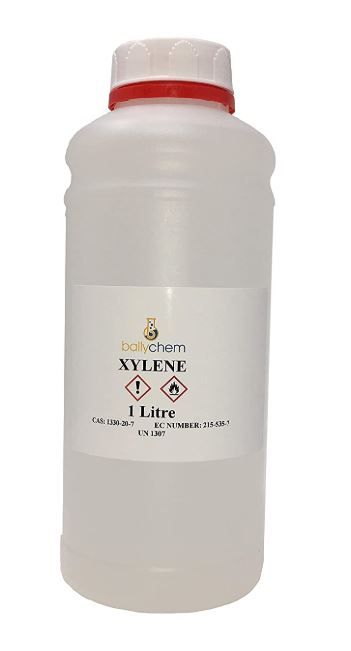XYLENE, 1 l, bot.
STD
SLASXYLE1B1
Valid Article
Account code:
60200
HS Code:
382290
Last Updated on:
15/05/2024, 22:00:39
Hazardous materials and products (identified by their 4-digit transport UN-number) must be transported under certain conditions as specified in the MSDS sheet (Material Safety Data Sheet).
Thermosensitive codes are defined for storage and transportation temperature requirements of the products.
XYLENE
Definition
Solvent used for removing grease from slides.
Synonym
Xylol.
Specifications
Technical specifications
- CAS N°: 1330-20-7
- Formula: C8H10 (C6H4 (CH3)2)
- Liquid reagent
- Quality: very pure, ultra pure
Packaging & Labelling
1 litre brown glass bottle
Transport Dangerous Goods
- UN1307
- Class: 3
- Packing group: III
- Proper shipping name: Xylenes
Instructions for use
CAUTION: Xylene is a corrosive product!
- Use a staining jar for soaking the slides and brucelle forceps for handling them.
- Clean the objectives with paper lightly impregnated with xylene (never dip them in xylene since there is a risk of loosening the lens).
- Do not use xylene to clean the stage and the eyepieces as it is a product which can seriously damage the microscope and irritate the eyes.
Please consult the “Updated laboratory procedures, 2022” available online via the Laboratory working Group sharepoint page: Laboratory Procedures and Resources.
https://msfintl.sharepoint.com/sites/msfintlcommunities/LabWG/SitePages/Laboratory-Manual-page.aspx
For offline access, contact your laboratory advisor.
Storage
- At room temperature: 15-25°C
- Upright, on the bottom shelves
- Keep away from from heat, sparks and open flame
- Keep container tightly closed in a dry and well-ventilated place
- No expiry date
Classification EC Regulation N° 1272/2008
- Flammable liquids: Category 3, H226
- Acute toxicity, Inhalation: Category 4, H312
- Acute toxicity, Dermal: Category 4, H332
- Skin corrosion/irritation: Category 2, H315
- Serious eye damage/eye irritation: Category 2, H319
- Specific target organ toxicity - single exposure (respiratory tract irritation): Category 3, H335
- Specific target organ toxicity - repeated exposure: Category 2, H373
- Aspiration hazard: Category 1, H304
- Chronic aquatic toxicity: Category 3, H412
Signal Word
Danger
| H226 | Flammable liquid and vapour. |
| H304 | May be fatal if swallowed and enters airways. |
| H315 | Causes skin irritation |
| H319 | Causes serious eye irritation |
| H335 | May cause respiratory irritation |
| H373 | May cause damage to organs (or state all organs affected, if known) through prolonged or repeated exposure (state route of exposure if it is conclusively proven that no other routes of exposure cause the hazard). |
| H412 | Harmful to aquatic life with long lasting effects |
| H312 + P332 | Harmful in contact with skin or of inhaled |
| P210 | Keep away from heat/sparks/open flames/hot surfaces. – No smoking. |
| P280 | Wear protective gloves/protective clothing/eye protection/face protection |
| P310 | Immediately call a POISON CENTER or doctor/physician. |
| P301 + P330 + P331 | IF SWALLOWED: rinse mouth. Do NOT induce vomiting |
| P303 + P361 + P353 | IF ON SKIN (or hair): Remove/Take off immediately all contaminated clothing. |
| P304 + P340 | IF INHALED: Remove to fresh air and keep at rest in a position comfortable for breathing. |
Some restricted information has been hidden. Sign in
to see this information


![[KMEDMLAB04D] (laboratory module) MALARIA REAGENTS, 1000 tests, RTR](/web/image/product.template/573208/image_256/%5BKMEDMLAB04D%5D%20%28laboratory%20module%29%20MALARIA%20REAGENTS%2C%201000%20tests%2C%20RTR?unique=569df3b)
![[KMEDMHLA14D] (mod hospital lab) REAGENTS regulated transport](/web/image/product.template/572571/image_256/%5BKMEDMHLA14D%5D%20%28mod%20hospital%20lab%29%20REAGENTS%20regulated%20transport?unique=bf82f3a)
![[KMEDMLAB103] (laboratory mod) TUBERCULOSIS REAGENTS ZN, 1000 tests, RTR](/web/image/product.template/573225/image_256/%5BKMEDMLAB103%5D%20%28laboratory%20mod%29%20TUBERCULOSIS%20REAGENTS%20ZN%2C%201000%20tests%2C%20RTR?unique=983e9ff)
![[ELABFOBR2--] FORCEPS, for holding slides, angled, inox](/web/image/product.template/570437/image_256/%5BELABFOBR2--%5D%20FORCEPS%2C%20for%20holding%20slides%2C%20angled%2C%20inox?unique=ef41160)
![[ELABJARS1--] STAINING JAR, glass, with lid](/web/image/product.template/570982/image_256/%5BELABJARS1--%5D%20STAINING%20JAR%2C%20glass%2C%20with%20lid?unique=ef41160)